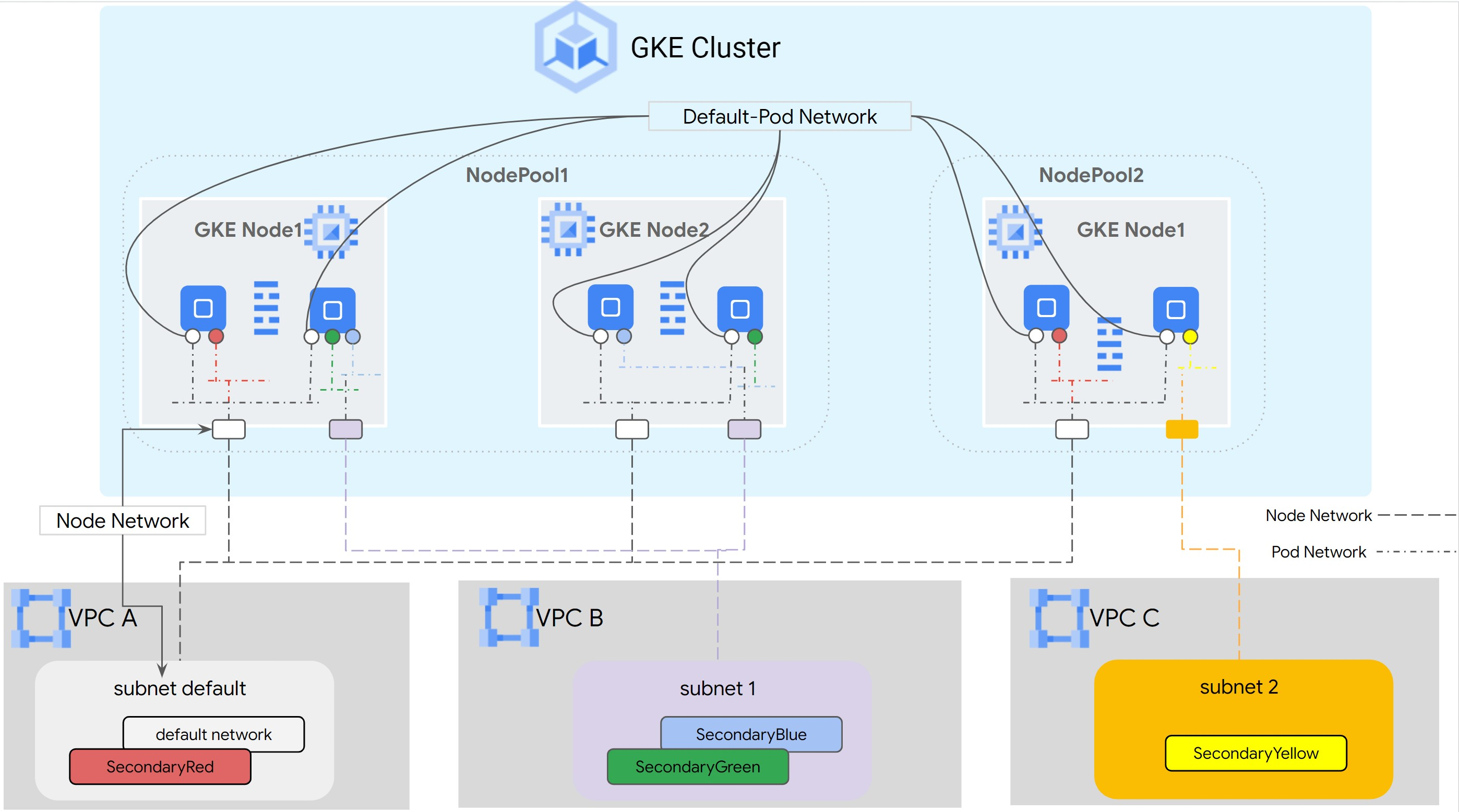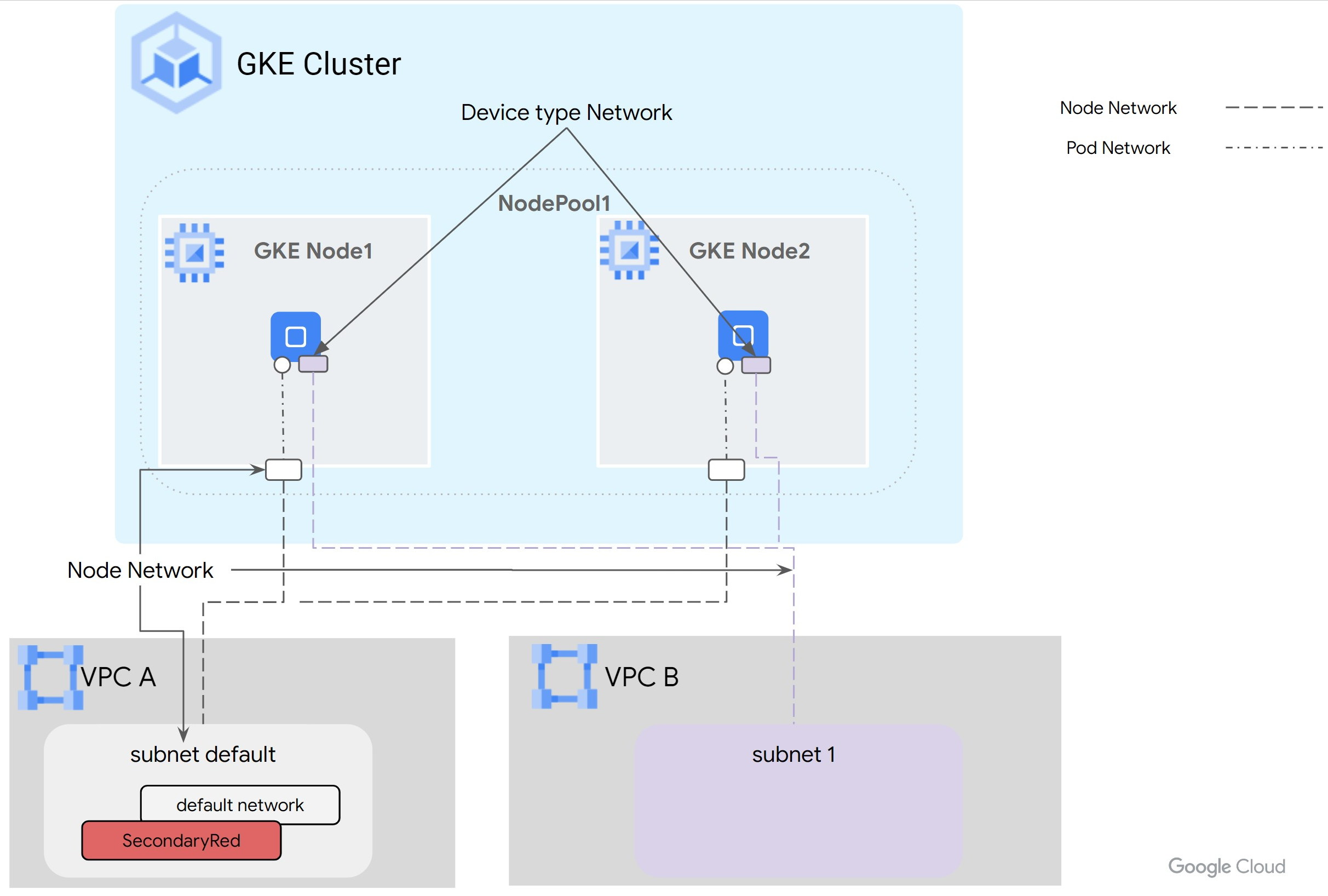This page describes multi-network support for Pods, including use cases, relevant concepts, terminology, and benefits.
Overview
Google Cloud supports multiple network interfaces at the virtual machine (VM) instance level. You can connect a VM to up to 8 networks with multiple network interfaces including the default network plus 7 additional networks.
Google Kubernetes Engine (GKE) networking extends multi-network capabilities to Pods that run on the nodes. With multi-network support for Pods, you can enable multiple interfaces on nodes and Pods in a GKE cluster. Multi-network support for Pods removes the single interface limitation for node pools, which limited the nodes to a single VPC for networking.
Network Function Optimizer (NFO) is a network service available to GKE that provides multi-network support and a high-performance Kubernetes-native dataplane. NFO enables containerized network functions on GKE. Multi-network is one of the fundamental pillars of NFO.
To use multi-network support for your Pods and nodes, see Set up multi-network support for Pods.
Terminology and concepts
This page uses the following concepts:
Primary VPC: The primary VPC is a pre-configured VPC that comes with a set of default settings and resources. The GKE cluster is created in this VPC. If you delete the pre-configured VPC, then the GKE cluster is created in the primary VPC.
Subnet: In Google Cloud, a subnet is the way to create Classless Inter-Domain Routing (CIDR) with netmasks in a VPC. A subnet has a single primary IP address range which is assigned to the nodes and can have multiple secondary ranges that can belong to Pods and Services.
Node-network: The node-network refers to a dedicated combination of a VPC and subnet pair. Within this node-network, the nodes belonging to the node pool are allocated IP addresses from the primary IP address range.
Secondary range: A Google Cloud secondary range is a CIDR and netmask belonging to a subnet. GKE uses this as a Layer 3 Pod-network. A Pod can connect to multiple Pod-networks.
Pod-network: A Network object that serves as a connection point for Pods.
The connection can either be of type Layer 3 or of type Device. You can
configure Device type Networks in netdevice or Data Plane Development Kit
(DPDK) mode.
Layer 3 networks correspond to a secondary range on a subnet. Device network
correspond to a subnet on a VPC. The data model for the
Pod-network in GKE multi-network is as follows:
For
Layer 3Network: VPC -> Subnet Name -> Secondary Range NameFor
DeviceNetwork: VPC -> Subnet Name
Default Pod-network: Google Cloud creates a default Pod-network during cluster creation. The default Pod-network uses the primary VPC as the node-network. The default Pod-network is available on all cluster nodes and Pods, by default.
Pods with multiple interfaces: Multiple interfaces on the Pods cannot connect to the same Pod network.
The following diagram shows a typical GKE cluster architecture
with Layer 3 Networks:

For Device typed Networks, which can be configured in netdevice or DPDK mode,
the VM vNIC is managed as a resource and passed to the Pod. The Pod-network maps
directly to Node-network in this case. Secondary ranges are not required for
Device typed Networks.

Use cases
Multi-network support for Pods address the following use cases:
- Deploy Containerized Network Functions: If you run the Network Functions in Containers, which have separate data and management planes. Multi-network for Pods isolates networks for different user planes, high performance or low latency from specific interfaces, or network level multi-tenancy. This is needed for compliance, QoS, and security.
- Connect VPC within the same organization and project: You want to create GKE clusters in a VPC and need to connect to services in another VPC. You can use the multi-NIC nodes option for direct connectivity. This might be due to a hub-and-spoke model, in which a centralized service (logging, authentication) operates within a Hub VPC, and the spokes require private connectivity to access it. You can use the multi-network support for Pods to connect the Pods running in the GKE cluster to the hub VPC directly.
- Run DPDK applications with VFIO: You want to run DPDK applications that require access to NIC on the node through the VFIO driver. You can achieve the optimal packet rate by bypassing the kernel, Kubernetes and GKE Dataplane V2 completely.
- Enable direct access to vNIC bypassing Kubernetes and GKE Dataplane V2: You run the Network Functions in Containers that requires direct access to the Network Interface Card (NIC) on the node. For example, High-Performance Computing (HPC) applications that want to bypass Kubernetes and GKE Dataplane V2 to achieve lowest latency. Some applications also want access to PCIe topology information of the NIC to collocate with other devices like GPU.
Benefits
Multi-network support for Pods provide the following benefits:
- Traffic isolation: Multi-network support for Pods lets you isolate traffic in a GKE cluster. You can create Pods with multiple network interfaces, to separate traffic based on capability, such as management and dataplane, within Pods running specific Cloud Native Functions (CNFs).
- Dual homing: Dual homing lets a Pod to have multiple interfaces and route traffic to different VPCs, allowing the Pod to establish connections with both a primary and secondary VPC. If one VPC experiences issues, the application can fall back to the secondary VPC.
- Network segmentation: Pods can connect to internal or external networks based on workload needs. Depending on the specific requirements of your workloads, you can choose which Pods or groups of Pods connect to each network. For example, you can use an internal network for east-west communication and an external network for internet access. This lets you to tailor the network connectivity of your workloads based on their specific needs.
- Optimal performance with DPDK: Multi-network support for Pods in GKE lets DPDK applications to run in GKE Pods, which provides optimal packet processing performance.
- Host NIC directly available in Pod: The
netdevicemode NIC support with multi-network passes VM NIC directly to Pod, bypassing Kubernetes and GKE Dataplane V2. This can achieve the lowest latency for collaboration between devices. - Performance: To improve your applications' performance, you can connect the applications to the network that is best suited for the applications' needs.
